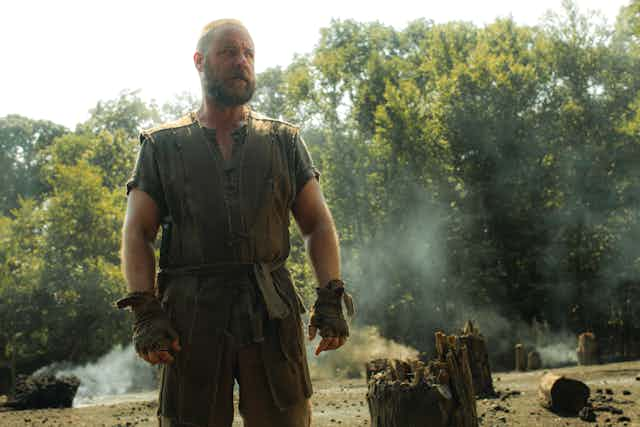The long-anticipated biblical epic, Noah, has been released to a tidal wave of reviews, comments and criticisms on the film’s “accuracy” in its adaptation of the flood narrative in Genesis. And granted, Aronofsky has taken some liberties with the story. His re-imagining of Noah’s ark is a noisy hybrid of The Road, The Lord of the Rings and, well, the Bible. Yet, among the groundswell of voices calling out the director on his infidelity to the text, there are few who’ve noticed that every biblically inspired cultural product adds and/or subtracts from the text.
Take a look at any children’s Bible. Very often, a kind-faced geriatric Noah looks out at the reader, with a happy rainbow and a couple of contented giraffes by his side. Popular cultural re-appropriations of the biblical story are sanitised, so distant from the grand-scale genocide of Genesis that Noah’s ark has become a standard children’s toy for families from every faith or none.

Now turn to the beautiful, blond, blue-eyed image of Jesus, which has become a cultural staple – faithful to the biblical text? We don’t get a physical description of Jesus in the New Testament, but it’s probably a stretch to imagine that a man from ancient Israel would look like a Californian surfer dude. Why don’t these “inaccuracies” create the same controversy as the recent Noah film?
Perhaps what makes the film unpalatable is that it’s so different from the re-tellings of the biblical flood story with which we’re familiar. Aronofsky doesn’t shirk from the representation of mass genocide with children’s Bible-esque gloss. In the biblical text, God is sorry that he’s created humankind and responds to their earthly violence with spectacular brutality, which is successfully tempered by the Bible’s spare language and detail. In the film the fierce savagery of the flood is visualised – we see innocents being killed (children, babies, animals are all mistreated and murdered during the film – not least by “The Creator”, whose actions wipes out all the shrieking, crying parents and toddlers indiscriminately).
Of course, the director does make some noticeable changes to the biblical story. To the sparse verses in Genesis he adds an adopted daughter/daughter-in-law, Ila (Emma Watson); a power-hungry king, Tubal-Cain (Ray Winstone); twin granddaughters, and some CGI generated “Watchers” – fallen angels trapped in stone “bodies” who are reminiscent of the Ents from The Two Towers.

Sure, Aronofsky has done some serious filling of gaps here, but who can blame him? The Bible is notoriously spare in its narratives and there are a lot of gaps to fill to carve a two-hour blockbuster from a few verses. But, commentary that recognises the similarities between the film and the text remains few and far between. This is surprising given that Noah is more faithful to the overarching themes of the biblical story then we might have been led to believe in the run up to the its general release.
Issues of gender and sexuality are central to this film, just as they are in the Bible. The Bible is clear: after the flood God wants humanity to “go forth and multiply”. The surviving creatures are in handily heterosexual couples to aid in the re-establishment of humankind on earth (although, according to our Hollywood Noah, humanity would be astonishingly free from racial diversity – every character in the film is white).
Aronofsky’s Noah, too, is incredibly traditional in its construction of gender and sexuality. The filmic Noah initially believes that humanity is inherently wicked and should die out, along with his immediate family, who he doesn’t want to procreate. Russell Crowe’s Noah says that each member of the family will bury an elder member, until only Japheth is left and humanity, and therefore wickedness, will die out with him.
But oddly, this absence of a divine procreation mandate in the film doesn’t diminish the huge value placed on heterosexuality and prescribed gender roles.

For example, Noah is a man. We know this because the genders of the cast are repeatedly pointed out and confirmed throughout the film. Ila, Noah’s daughter, is a woman, but not a “real woman” because femininity, what it means to be female – really female – in the film, is to possess a functional womb. Ila becomes upset because the fertility issues caused by an childhood injury mean that she isn’t a “real woman”, and she pleads with Noah to find a “proper wife” for Shem. No one in the film takes issue with this construction of femininity and any difficulties are sloughed off when Methuselah (Antony Hopkins) magically repairs Ila’s reproductive organs with a touch of his hand.
Ham, on the other hand, is alone – desperately alone. Both Noah and Tubal-Cain demand that Ham demonstrate his masculinity on a number of occasions throughout the film, culminating in Tubal-Cain’s pronouncement of Ham’s manhood during his death scene aboard the ark: “Now, you are a man.” His solitariness is distinctly couched in terms of desire for a heterosexual female mate. He finds a partner, but Noah leaves her to die rather than take her on the ark, an act so devastating for Ham that he never forgives his father for the betrayal.
Noah, then, for all its GGI effects, mysterious Watchers and character additions, can’t quite disguise that its 21st-century incarnation of the biblical hero remains closer to the Bible than any of us might have guessed.
Fidelity to the text? It’s a storm in a teacup.

